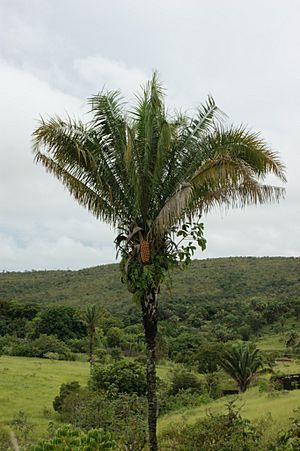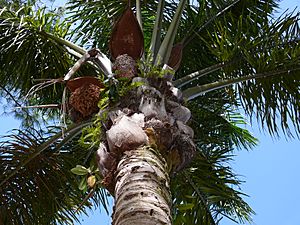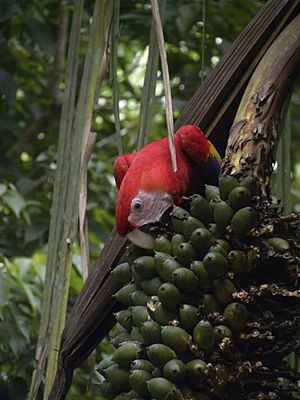Attalea (plant) facts for kids
Quick facts for kids Attalea (plant) |
|
|---|---|
 |
|
| Attalea brasiliensis | |
| Scientific classification |
|
| Kingdom: | Plantae |
| Clade: | Tracheophytes |
| Clade: | Angiosperms |
| Clade: | Monocots |
| Clade: | Commelinids |
| Order: | Arecales |
| Family: | Arecaceae |
| Subfamily: | Arecoideae |
| Tribe: | Cocoseae |
| Genus: | Attalea Kunth |
| Type species | |
| Attalea amygdalina Kunth
|
|
| Diversity | |
| Between 29 and 67 species | |
| Synonyms | |
|
|
Attalea is a large group of palm trees. They are found naturally in Mexico, the Caribbean, Central, and South America. These palms have feather-like leaves and do not have thorns. Some Attalea palms are small with no visible trunk, while others are huge trees.
Scientists have had a hard time classifying these palms. They used to split them into four or five different groups. This was based on how their male flowers looked. But it was hard to tell them apart, and some palms had flowers that were in-between types. Also, different groups could create hybrid palms. This made scientists think they should all be in one big group. Recent studies using DNA have supported this idea.
There are between 29 and 67 known species in the Attalea group. Some experts think there might be as many as 100. It's tough to know for sure because not enough plant samples have been collected. Attalea palms have been used by humans for a very long time. They are important for making palm oil and strong fibres. Many species can survive fires and grow well in places where the land has been changed by humans. Animals help spread their seeds. Some seeds might even have been spread by very large animals that lived long ago, like mammoths, but are now extinct.
Contents
What Do Attalea Palms Look Like?

Attalea palms do not have spines. Their leaves are "pinnately compound." This means they have many small leaflets arranged like a feather on both sides of a central stem. Some Attalea species are very tall trees, growing up to 30 meters (about 100 feet) high. Others are "acaulescent," meaning they don't have an above-ground trunk. They look like a bunch of leaves growing straight from the ground.
These palms usually have between 3 and 35 leaves. Larger plants tend to have more and longer leaves. Their flower clusters, called inflorescences, are large and branched. They grow among the leaves. Each cluster has a main stalk and smaller branches that hold the flowers. Some flower clusters have only male flowers. Others have mostly female flowers with a few male ones. The fruits usually have two or three seeds. They are typically brown, yellow, orange-brown, or purple when they are ripe.
Scientists used to classify Attalea palms into four main groups based on their male flowers. These groups were called Attalea (in a narrow sense), Orbignya, Maximiliana, and Scheelea. For example, Orbignya palms have coiled parts in their male flowers, while others have straight ones. But some Attalea species have flowers that are a mix of these types. This is one reason why most scientists now agree that they should all be considered one single group.
How Are Attalea Palms Classified?
|
||||||||||||||||||||||||||||||||||||||||||||||||||||||||||||||||||
| Simplified family tree of some palms, including Attalea. |
Attalea palms belong to the palm family, called Arecaceae. They are part of a smaller group within this family called Attaleinae. Other palms in this group include the coconut and Butia palms. Scientists use family trees, called cladograms, to show how different plants are related. This helps them understand how species evolved.
For a long time, scientists disagreed about whether Attalea should be one large group or several smaller ones. In 1996, some botanists decided to put all these related palms into one genus, Attalea. But in 1999, another botanist divided them into five different groups. This was mainly based on the male flowers. However, some species had flowers that didn't fit neatly into any of these groups. Also, hybrids (mixes) of these different groups were found. This suggested they were all closely related enough to be in one genus. More recent studies, looking at the DNA of these palms, have shown that treating Attalea as one single group makes the most sense.
How Attalea Got Its Name
The name Attalea was first used in 1816 by a scientist named Carl Sigismund Kunth. He named the genus after Attalus III Philometor. Attalus was a king of Pergamon who was very interested in medicinal plants. The first species described in this group was Attalea amygdalina, which grows only in Colombia. Other related palm groups, like Maximiliana and Orbignya, were named later in the 1800s.
How Many Attalea Species Are There?
Experts don't all agree on the exact number of Attalea species. In 1965, one scientist thought there might be as many as 100 species. In 1996, a book listed 29 species. But in 1999, another expert recognized 65 species. By 2005, a worldwide list of palms recognized 67 species.
Part of the problem is that some scientists define a "species" more broadly than others. So, what one scientist sees as slight differences within one species, another might see as completely separate species. It's also hard to study these palms because their leaves, flowers, and fruits are very large. This makes them difficult to collect and store in plant collections (herbaria). Many important samples have also been lost or destroyed over time. All these things make it tricky to figure out exactly how many different Attalea species exist. Also, different species often hybridize, meaning they cross-breed, which adds to the confusion.
How Attalea Palms Grow and Reproduce
Attalea palms are "monoecious." This means that a single palm plant has both male and female flowers. Insects help pollinate some species, like Attalea phalerata. Other species, like A. colenda and A. speciosa, can be pollinated by both insects and wind. Animals play a big role in spreading the seeds of Attalea palms.
When an Attalea seed sprouts, the young shoot grows downwards first, away from the seed. Then, it turns and grows upwards to form the trunk. This creates a unique "saxophone shaped" part of the stem underground. Because the growing tip of the seedling is underground, it helps the palm survive fires.
Where Do Attalea Palms Live?

Attalea species are found all over the warm regions of the Americas. They stretch from Mexico in the north down to Bolivia, Paraguay, and southern Brazil. They can grow in low coastal areas or high up in the Andes mountains, at elevations up to 1,600 meters (about 5,200 feet).
Most Attalea species (around 62) are found in South America. Four species are in Central America, and three are in Mexico. Only three species are found in the Caribbean: two in Trinidad and Tobago, and one in Haiti.
Attalea Habitats and Wildlife
Attalea palms include both large trees and smaller palms without trunks. They live in many different kinds of environments. Some large species form dense groups that are easy to spot in the landscape. Smaller species can be found growing under taller trees in forests or in open grasslands called savannas.
Human activities and natural events can help large Attalea palms grow in certain areas. For example, in parts of the Amazon, more large A. maripa palms grow where the forest canopy is more open. This species also takes over savannas in Trinidad and Tobago after repeated forest fires. A. speciosa forms pure stands in Brazil where natural forests have been cleared. Similarly, Attalea funifera groves in Brazil are managed using fire. The young palms survive burning and can then dominate the burned areas.
Animals help spread the fruits of Attalea palms. If the fruits aren't spread, insects often eat the seeds. Some Attalea species are thought to have evolved to have their seeds spread by very large animals that are now extinct, like the giant sloths and mammoths of the Ice Age. Today, animals like tapirs, peccaries, deer, and monkeys eat A. maripa fruits. Rodents like agoutis also eat the fruits and, when fruits are scarce, they eat the seeds. Birds like crested caracaras also eat Attalea fruits and help spread the seeds.
How People Use Attalea Palms
People have used Attalea palms for thousands of years. For example, burnt seeds of Attalea maripa have been found at old human sites in Colombia, dating back 9,000 years. Even today, several Attalea species are important. They provide edible oil, material for thatching roofs, edible seeds, and strong fibres.
The leaves of Attalea butyracea and A. maripa are widely used for thatching. Several species are also important oil palms. A. speciosa is one of the most important for its oil. In 2005, products from A. speciosa helped support over 300,000 families in one Brazilian state. In 1985, it was estimated to support over 450,000 families across Brazil. Strong fibres called piassava are taken from the leaf bases of A. funifera. These fibres are very valuable. In 1996, they brought in about US$20 million in yearly income for Brazilian farmers.
Images for kids
See also
 In Spanish: Attalea para niños
In Spanish: Attalea para niños




